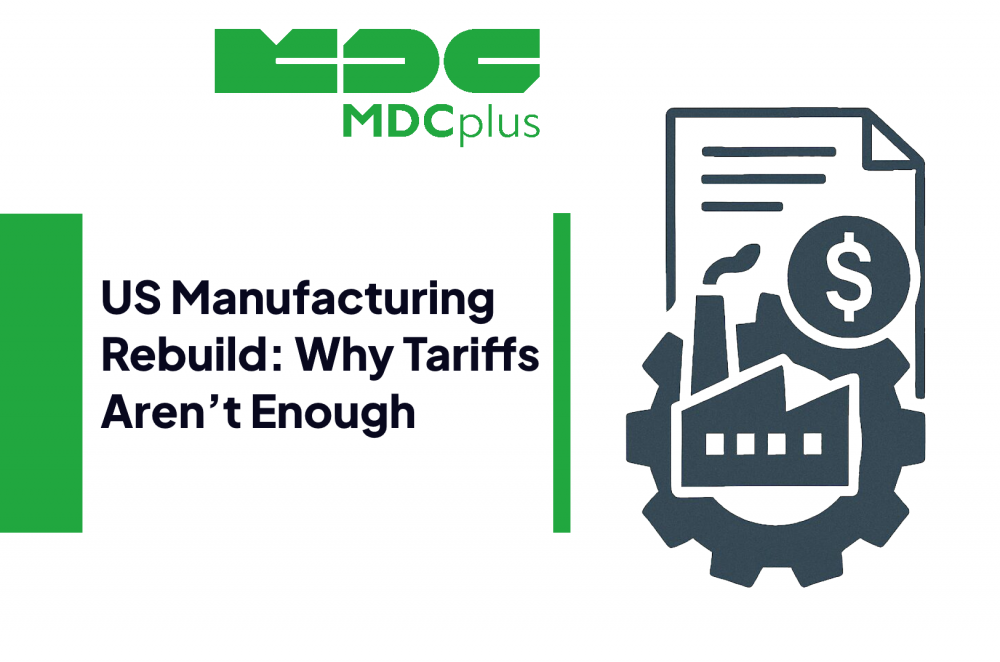US Manufacturing Rebuild: Why Tariffs Aren’t Enough
For decades, the debate around American manufacturing has recycled the same talking points: lost jobs, global competition, and the promise of bringing production back home. In this cycle, the go-to lever has always been tariffs. But tariffs alone won’t build a machine shop, retrain a workforce, or reboot an industrial base that’s been hollowed out for decades.
What we need now isn’t just protection – it’s capability. And in 2025, that means leveraging the rare opportunity in front of us: aligned industrial policy, historic federal funding, and the rise of smarter, digitized production.
The Shrinking Base: What's Actually Been Lost
U.S. manufacturing still ranks second globally by volume. But that headline masks the reality on the ground. In the 1950s, manufacturing represented 25% of U.S. GDP. Today, it's closer to 10%. Since the 1980s, the U.S. has lost thousands of foundries, casting shops, and metalworking facilities – much of that capacity shifted to China.
This wasn’t driven by automation alone. A combination of low-cost labor abroad, misaligned policy, and underinvestment at home made it cheaper to offshore than modernize. The consequences showed up in full force during COVID-era shortages: medical devices, chips, basic components – all suddenly out of reach.
We didn’t just lose production. We lost the infrastructure to respond.
The Real Turning Point: OBBB and Industrial Policy With Teeth
Enter the legislative shift many are calling the One Big Beautiful Bill – a shorthand for the combined force of the CHIPS Act, Inflation Reduction Act, and Infrastructure Investment and Jobs Act. Together, these bills pump trillions into sectors that depend on manufacturing: semiconductors, clean energy, infrastructure, electric vehicles, and defense.
For the first time in decades, there’s national-scale demand for domestic production – and a government willing to back it with capital.
This is more than politics. It’s a strategic realignment: from lowest-cost sourcing to resilient, local capacity. And it's creating real urgency for American manufacturers to modernize, grow, and scale – not five years from now, but today.
Four Moves to Turn Policy into Progress
Here’s what we actually need to make this moment count:
1. Tariffs Should Fund Tech – Not Sit in Treasury
Redirect a portion of tariff revenue to small and midsize manufacturers. Invest it in robotics, AI, CNC upgrades, and training – not tax credits that reward size over agility. Germany’s Mittelstand model has proven how targeted, long-term support for small shops builds resilience and export strength.
2. Remove the Permitting Bottleneck
Federal funds are flowing, but red tape still blocks deployment. Create fast-track “Manufacturing Innovation Zones” that allow projects to go from plan to groundbreaking in under 90 days. Cities like Austin and Phoenix proved it’s possible – now scale it nationwide, especially in industrial regions hit hardest by deindustrialization.
3. Expand the Workforce – Especially Through Second-Chance Hiring
By 2030, the U.S. will face a shortage of over 2 million skilled manufacturing workers. At the same time, more than 600,000 people exit the prison system each year. With proper support, second-chance hiring can close real workforce gaps. Programs like MAGNET in Cleveland have already shown strong job placement and low recidivism. OBBB-aligned policy should make this a national strategy.
4. Reward Breakthrough Ideas with Real Incentive
Create a Manufacturing Renaissance Prize – modeled after DARPA’s Grand Challenges – to reward disruptive ideas that enable reshoring, automation, or new production models. Combine public capital, private competition, and federal visibility to drive urgency.
Don’t Overlook the Digital Layer
Much of the conversation around manufacturing focuses on buildings, machines, and jobs. But in 2025, digital infrastructure is what separates resilient shops from fragile ones.
Platforms like MDCplus, for example, offer real-time machine monitoring, predictive maintenance triggers, and NC program tracking – all without overhauling existing equipment. They let small shops compete with large plants by making smarter use of limited staff and resources.
Digitization doesn’t replace labor. It amplifies it. And it’s what allows manufacturers to meet the demands of OBBB-funded projects, where traceability, performance data, and uptime aren’t optional – they’re required.
The Institutions Are in Place – We Just Need to Use Them
Programs like the Manufacturing Extension Partnership (MEP) already exist in all 50 states. They offer technical assistance, modernization planning, and training resources specifically for small and midsize firms. Yet they remain underfunded – even as demand rises.
OBBB should lock in permanent funding for MEP, scale its reach, and integrate it with other workforce and innovation initiatives. If we have national priorities, we need national infrastructure to deliver them.
This Isn’t About Nostalgia – It’s About Control
The mission isn’t to “bring back” the past. It’s to build forward – with tools, skills, and strategy that match the complexity of the current moment.
We’ve been handed something rare: aligned policy, capital, and public attention. But without execution, that momentum fades. Tariffs alone won’t restore what’s been lost. Neither will slogans.
Now is the time to retrain, retool, and rebuild American manufacturing – not in theory, but in code, metal, and people.
About MDCplus
Our key features are real-time machine monitoring for swift issue resolution, power consumption tracking to promote sustainability, computerized maintenance management to reduce downtime, and vibration diagnostics for predictive maintenance. MDCplus's solutions are tailored for diverse industries, including aerospace, automotive, precision machining, and heavy industry. By delivering actionable insights and fostering seamless integration, we empower manufacturers to boost Overall Equipment Effectiveness (OEE), reduce operational costs, and achieve sustainable growth along with future planning.
Ready to increase your OEE, get clearer vision of your shop floor, and predict sustainably?
